Safety Innovation #13: Avoiding ground collisions

In 1977, Tenerife airport was the scene of a devastating ground collision between two passenger aircraft, the first one taking off and the other taxiing on the same runway. This remains the world’s deadliest aviation accident.
The subsequent investigation found two main causes. The first was a misunderstanding between Air Traffic Control (ATC) and the flight crew of the aircraft that was taking off. The second was a lack of coordination between the flight crew members to ensure that the runway was cleared for takeoff.
Based on these conclusions, the airline industry has gradually made improvements in three main areas:
- Clear communication between ATC and flight crews using standard phraseology;
- Effective Crew Resource Management (CRM) in the cockpit;
- Enhancement of flight crew awareness about traffic on the taxiway and runway.
The Tenerife accident is just one of many ground collisions that have occurred over the long history of air transport. Various industry players have acted to reduce collision risks during the past decades but continuous improvement is vital given the increasing congestion at many airports.
Airbus is currently developing a new system to prevent runway collisions: the onboard SURFace Alerting function (SURF-A). It will further enhance flight crew awareness about traffic on ground with pertinent alerts. Using data continuously emitted by commercial aircraft about their position, altitude and speed – through Automatic Dependent Surveillance-Broadcast (ADS-B) technology – SURF-A continuously monitors surrounding traffic on the runway. If a ground collision risk is detected while an aircraft is taking off, the system alerts the flight crew so they can take appropriate action. Similarly, if a collision risk is detected while an aircraft is on final approach, SURF-A warns the flight crew so they can perform a go-around.
Many runway incursions occur each year at airports around the world, leading to a risk of ground collisions between aircraft taking off or landing. SURF-A will help to mitigate these situations.



